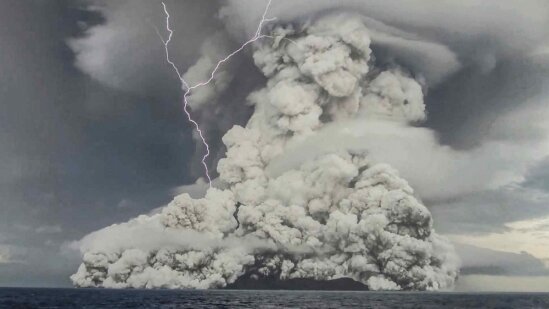The recent eruption of Tonga’s Hunga Tonga–Hunga Ha‘apai volcano, at 04:14:45 UT on Jan. 15 has just been found to have caused huge global disturbances in the Earth’s atmosphere.
The data used was recorded by 5,000 Global Navigation Satellite System (GNSS) ground receivers located around the globe, MIT Haystack Observatory scientists and their international partners from the Arctic University of Norway have observed substantial evidence of eruption-generated atmospheric waves and their ionospheric imprints 300 kilometers above the Earth’s surface over an extended period.
These atmospheric waves were active for at least four days after the eruption and circled the globe three times.
It released energy equivalent to 1,000 atomic bombs of the size deployed in 1945.

When over the ocean, this can trigger tsunami waves, and therefore upper-atmospheric disturbances.
A new study, led by researchers at MIT Haystack Observatory and the Arctic University of Norway, reporting the results was published in the peer-reviewed journal Frontiers in Astronomy and Space Sciences.
The authors have attributed the disturbances to Lamb waves. These waves travel at the speed of sound globally without much reduction in amplitude.
As stated in the new paper, “prevailing Lamb waves have been reported before as atmospheric responses to the Krakatoa eruption in 1883 and other geohazards. This study provides substantial first evidence of their long duration imprints up in the global ionosphere.”
Under National Science Foundation support, Haystack has been assembling global GNSS network observations to study important total electron content information daily since 2000.

Ionospheric disturbances (TIDs) are often excited by processes including sudden energy inputs from the sun, terrestrial weather, and human-made disturbances. For example, Haystack scientists used TID observations to provide the first evidence that solar eclipses can trigger bow waves in Earth’s atmosphere.
Lead author Shunrong Zhang says, “Only severe solar storms are known to produce TID global propagation in space for several hours, if not for days; volcanic eruptions and earthquakes normally yield ionospheric disturbances only within thousands of kilometers. By detecting these significant eruption-induced ionospheric disturbances in space over very large distances, we found not only the generation of Lamb waves and their global propagation over several days (often monitored as sound waves on the ground for compliance with Comprehensive Nuclear Test Ban Treaties) but also a fundamentally new physical process. In the end, surface and lower atmospheric signals can make a loud splash, even deep in space.”


